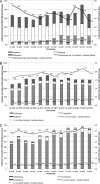Surveillance and correlation of antibiotic prescription and resistance of Gram-negative bacteria in Singaporean hospitals
- PMID: 20065055
- PMCID: PMC2826017
- DOI: 10.1128/AAC.01076-09
Surveillance and correlation of antibiotic prescription and resistance of Gram-negative bacteria in Singaporean hospitals
Abstract
A surveillance study was performed in four Singapore public hospitals from 2006 to 2008 to determine the correlation between antibiotic prescription and Gram-negative bacterial antimicrobial resistance. Targeted organisms included ceftriaxone- and ciprofloxacin-resistant Escherichia coli and Klebsiella pneumoniae, as well as imipenem-resistant Pseudomonas aeruginosa and Acinetobacter spp. Antibiotic prescription data were collated in the WHO anatomical therapeutic chemical (ATC)/defined daily dose (DDD) format, while antibiotic resistance was expressed as incidence density adjusted for total inpatient-days every quarter. Individual trends were determined by linear regression, while possible associations between antibiotic prescription and resistance were evaluated via cross-correlation analysis. Results over 3 years indicated significantly rising incidence densities of ceftriaxone- and ciprofloxacin-resistant E. coli and imipenem-resistant Acinetobacter spp. (blood isolates only). Antimicrobial-resistant Klebsiella pneumoniae rates declined. The prescription rates of piperacillin-tazobactam, ertapenem, meropenem, ciprofloxacin, and levofloxacin increased significantly, while imipenem and moxifloxacin prescription decreased. Cross-correlation analysis demonstrated possible associations between prescription of fluoroquinolones and ciprofloxacin-resistant E. coli (R(2) = 0.46), fluoroquinolones and ceftriaxone-resistant E. coli (R(2) = 0.47), and carbapenems and imipenem-resistant Acinetobacter spp. (R(2) = 0.48), all at zero time lag. Changes in meropenem prescription were associated with a similar trend in imipenem-resistant Acinetobacter blood isolates after a 3-month time lag. No correlation was found between cephalosporin use and resistance. In conclusion, our data demonstrated correlation between prescription of and Gram-negative bacterial resistance to several, but not all, key antimicrobial agents in Singapore hospitals. In areas where Gram-negative bacterial resistance is endemic and prescription of broad-spectrum antimicrobial agents is high, factors other than antimicrobial usage may be equally important in maintaining high resistance rates.
Figures


References
-
- Bartoloni, A., F. Bartalesi, A. Mantella, E. Dell'Amico, M. Roselli, M. Strohmeyer, H. G. Barahona, V. P. Barron, F. Paradisi, and G. M. Rossolini. 2004. High prevalence of acquired antimicrobial resistance unrelated to heavy antimicrobial consumption. J. Infect. Dis. 189:1291-1294. - PubMed
-
- Bergman, M., S. T. Nyberg, P. Huovinen, P. Paakkari, A. J. Hakanen, and the Finnish Study Group for Antimicrobial Resistance. 2009. Association between antimicrobial consumption and resistance in Escherichia coli. Antimicrob. Agents Chemother. 53:913-917. - PubMed
-
- Boucher, H. W., G. H. Talbot, J. S. Bradley, J. E. Edwards, D. Gilbert, L. B. Rice, M. Scheld, B. Spellberg, and J. Bartlett. 2009. Bad bugs need drugs: no ESKAPE! An update from the Infectious Diseases Society of America. Clin. Infect. Dis. 48:1-12. - PubMed
-
- Clinical and Laboratory Standards Institute. 2005. Performance standards for antimicrobial susceptibility testing. Supplement M100-S14, vol. 24, no. 1. Clinical and Laboratory Standards Institute, Wayne, PA.
-
- Clinical and Laboratory Standards Institute. 2006. Analysis and presentation of cumulative susceptibility test data; approved guideline, 2nd ed. Document M39-A2, vol. 25, no. 28. Clinical and Laboratory Standards Institute, Wayne, PA.
Publication types
MeSH terms
Substances
LinkOut - more resources
Full Text Sources
Medical
Research Materials
Miscellaneous

